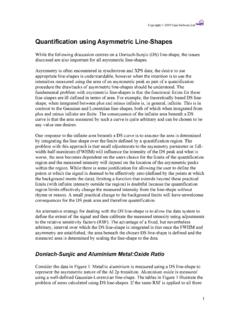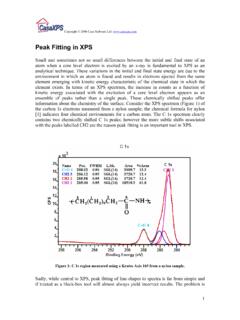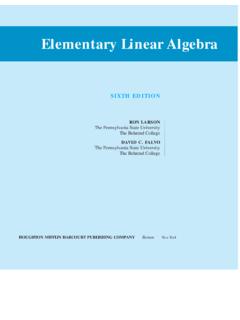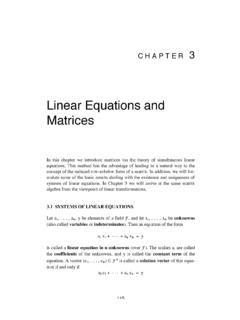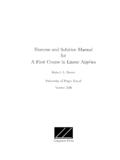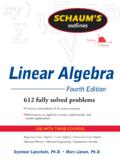Transcription of Solving Simultaneous Equations and Matrices - …
1 Copyright 2011 Casa Software Ltd. Solving Simultaneous Equations and Matrices The following represents a systematic investigation for the steps used to solve two Simultaneous linear Equations in two unknowns. The motivation for considering this relatively simple problem is to illustrate how matrix notation and algebra can be developed and used to consider problems such as the rotation of an object. Examples of how 2D vectors are transformed by some elementary Matrices illustrate the link between Matrices and vectors. Consider a system of two Simultaneous linear Equations : Multiply Equation (1) by and Equation (2) by : Subtract Equation (4) from Equation (3).
2 Making the subject of the equation, assuming : Similarly, multiply Equation (1) by and Equation (2) by : Subtract Equation (7) from Equation (8). Making the subject of the equation, assuming : Equations (6) and (10) provide a solution to the Simultaneous Equations (1) and (2). Introducing matrix notation for the Simultaneous Equations (1) and (2) these solutions (6) and (10) form a pattern as follows. Define the matrix then . Then introduce two Matrices formed from by first replacing the coefficient to in Equations (1) and (2) by the right-hand side values, then forming the second matrix by replacing the coefficient of by the same right-hand side values yields 1.
3 Copyright 2011 Casa Software Ltd. and Thus and , therefore the solutions (6) and (10) can be written as follows, provided . and As an alternative the Equations (6) and (10) can be expressed in matrix notation as follows Thus Given the matrix , the matrix is known as the inverse of with the property that The solution to Equations (1) and (2) can therefore be expressed as follows. Given a pair of Simultaneous Equations form the matrix equation calculate the inverse matrix then express the solution using 2. Copyright 2011 Casa Software Ltd.
4 Equation (11) shows that the solution is obtained by matrix multiplication of the right-hand side of the Equations (1) and (2) by a matrix entirely created from the coefficients of the and terms in these Equations . Geometrically speaking, the coefficients , , and define a pair of straight lines in a 2D plane in terms of the slope for these lines. The right-hand side values for a given set of coefficients determine the intercept values for these lines and specifying the values for and define two lines from the infinite set of parallel lines characterised by the coefficients , , and.
5 Equation (11) states that it is sufficient to consider the directions for these lines in order to obtain a general method for determining the point at which specific lines intersect. For example, when given a pair of Simultaneous Equations the point of intersection for all Equations of the form can be prepared by considering the matrix . If then . The inverse matrix is therefore 3. Copyright 2011 Casa Software Ltd. With the exception of the last step, each step in the solution can be performed without reference to the values from the right-hand side.
6 The solution is therefore obtained by considering the homogenous Equations corresponding to a pair of lines passing through the origin. The method of solution fails whenever . Since the failure occurs if 4. Copyright 2011 Casa Software Ltd. which geometrically means the two lines defined by the Simultaneous Equations (1) and (2) have the same slope and are therefore parallel. Parallel lines are either identical or the lines never intersect one another, therefore no single point can satisfy both Equations . A matrix such that is said to be singular.
7 Linear Transformations defined by Matrices Rotation by in an anticlockwise direction about the origin 5. Copyright 2011 Casa Software Ltd. Rotation about the origin by an angle of is achieved by transforming a point by matrix multiplication by The shape with vertices is transformed by the rotation matrix through matrix multiplication as follows. Reflection about a line making an angle of in an anticlockwise direction with the x-axis Consider first the result of reflecting the unit vector in the direction of the x-axis. Next consider the result of reflecting the unit vector in the direction of the y-axis.
8 6. Copyright 2011 Casa Software Ltd. Reflection in a line through the origin making an angle with the x-axis is therefore Reflection in a line making an angle of with the x- axis passing through the origin is achieved by transforming a point by matrix multiplication The shape with vertices is transformed by the reflection matrix through matrix multiplication as follows. 7. Copyright 2011 Casa Software Ltd. Examples of Matrix Transformations Reflection in the y-axis Rotation about the origin by radians 8. Copyright 2011 Casa Software Ltd.
9 Reflection in the y-axis followed by a rotation by about the origin Rotation by about the origin followed by a Reflection in the y-axis 9. Copyright 2011 Casa Software Ltd. Reflection in the line Rotation about the origin by radians 10. Copyright 2011 Casa Software Ltd. Reflection in the followed by a rotation by about the origin Rotation by about the origin followed by a reflection in the 11. Copyright 2011 Casa Software Ltd. Mapping Shapes of known Area Consider how a matrix transforms an area of unit size to a new area.
10 By considering a square defined by the unit vectors and therefore of unit area, the relationship between the initial area of a shape to the area of the transformed shape is shown to be dependent on the determinant of the matrix . A square is transformed by to a parallelogram as follows. A matrix of the form transforms the unit square to a parallelogram with area . The square defined by the unit vectors and after transformation by become the vector and . 12. Copyright 2011 Casa Software Ltd. The area of a parallelogram defined by and is given by If the base is taken to be the vector the length of the base is , and the perpendicular height is , where is the angle between and Since the dot product between vectors gives Now, and , therefore , and An object with area of one unit is transformed by the matrix to an object of area.

